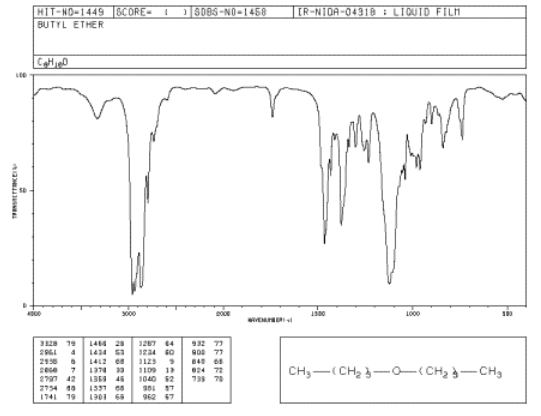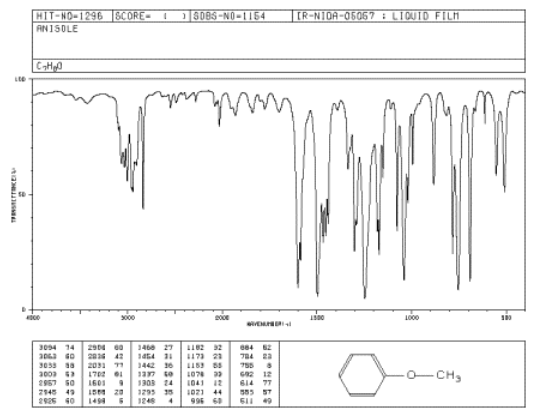3.5: Bonds to Common Heteroatoms- Oxygen
- Page ID
- 189765
These bonds are pretty polar, so they show up strongly in IR spectroscopy. IR spectroscopy is therefore a good way to determine what heteroatom-containing functional groups are present in a molecule.
Compounds Containing C-O Single Bonds
Oxygen forms two bonds. An oxygen atom could be found in between two carbons, as in dibutyl ether, or between a carbon and a hydrogen as in 1-butanol. Dibutyl ether is an example of an ether and 1-butanol is an example of an alcohol.

If you look at an IR spectrum of dibutyl ether, you will see:
- there are the usual sp3 C-H stretching and CH2 bending modes at 2900 and 1500 cm-1.
- there is a strong peak near 1000 cm-1. This peak is due to the C-O stretching vibration.

Source: SDBSWeb : http://riodb01.ibase.aist.go.jp/sdbs/ (National Institute of Advanced Industrial Science and Technology of Japan, 14 July 2008)
If you look at an IR spectrum of 1-butanol, you will see:
- there are sp3 C-H stretching and CH2 bending modes at 2900 and 1500 cm-1.
- there is a strong C-O stretching mode near 1000 cm-1.
- there is a very large peak around 3400 cm-1. O-H peaks are usually very broad like this one.

Source: SDBSWeb : http://riodb01.ibase.aist.go.jp/sdbs/ (National Institute of Advanced Industrial Science and Technology of Japan, 14 July 2008)
Peak shapes are sometimes very useful in recognizing what kind of bond is present. The rounded shape of most O-H stretching modes occurs because of hydrogen bonding between different hydroxy groups. Because protons are shared to varying extent with neighboring oxygens, the covalent O-H bonds in a sample of alcohol all vibrate at slightly different frequencies and show up at slightly different positions in the IR spectrum. Instead of seeing one sharp peak, you see a whole lot of them all smeared out into one broad blob. Since C-H bonds don't hydrogen bond very well, you don't see that phenomenon in an ether, and an O-H peak is very easy to distinguish in the IR spectrum.
Even though there are only two C-O bonds in dibutyl ether, the C-O stretching mode is even stronger than the peak at 2900 cm-1 arising from 10 different C-H bonds. Explain why.
- Answer
-
The C-O bond is much more polar than the C-H bond. More polar bonds absorb IR light much more strongly than less polar or nonpolar ones.
The IR spectrum of methyl phenyl ether (aka anisole) has strong peaks at 1050 and 1250 cm-1.

- Identify the type of bond corresponding to these two peaks.
- Why are there two peaks for this type of bond in this molecule, and not just one?
- Draw a second, zwitterionic resonance structure for methyl phenyl ether.
- Use the zwitterionic resonance structure to explain why one of these bonds shows up at a higher frequency than the other one.

Figure \(\PageIndex{3}\): IR spectrum of methyl phenyl ether.
Source: SDBSWeb : http://riodb01.ibase.aist.go.jp/sdbs/ (National Institute of Advanced Industrial Science and Technology of Japan, 14 July 2008)
- Answer
-
a) These peaks correspond to C-O stretches.
b) There are two distinguishable C-O bonds: one is a Csp2-O bond between the oxygen and the aromatic; the other is a Csp3-O bond between the oxygen and the aliphatic methyl group.
c) The bond to the aromatic has some double bond character because of conjugation.

d) The partial double bond character means the Csp2-O bond is a little stronger than the Csp3-O bond and so the Csp2-O bond shows up at a higher frequency.


